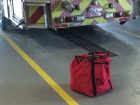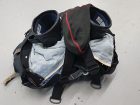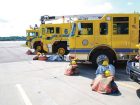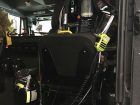
Features
Communication
Training
Back to Basics: March 2019
Last month, we looked at the factor of not inspecting our PPE and the consequences that results from the absence of it. This absence leads into the complacency factor that prevails in the fire station and on the fire ground.
February 15, 2019
By Mark van der Feyst
We are going to continue our look at our PPE and complacency with the factor of our PPE being readied to go, or, in other words, combat ready.
The term “combat ready” is a term that we use to denote how our PPE should always be – in a readied state. This term is not new to the fire service, nor was it coined by the fire service. This term has been adopted into the fire service from the military.
When we look at the different types of fire department organizations – full time, part time, composite or volunteer – we can apply this term in different ways to accommodate the operational mode.
So why the readied state for our PPE? It comes down to a matter of time. We need to be efficient and effective with everything that we do, and this includes our response times. Time starts ticking against us the moment that a person needing help calls 911, then it is answered by 911, directed to the appropriate party (police, fire or EMS), then sent off to the fire station for dispatch.
Our response time starts when the tones are activated for us to respond – this includes the time from when the tone goes off, to it being acknowledged, to the crew getting dressed and ready to go, to the fire truck leaving the station and then arriving on scene. We can shave off precious seconds with the time it takes to get dressed and ready to leave on the truck. This is where being combat ready comes into play with our PPE.
In the photo at the top right, we can see an example of not being combat ready. The person who owns this gear decided to roll the dice with respect to a call coming that day. It was reported that this individual came to work that morning, dropped the gear bag behind the truck he or she was assigned to, and left it there for the entire shift. To really set the example, this was the officer of the truck. As apparent as this example is, it hits the message home that our PPE needs to be in a readied state, not in a relaxed state.
So what areas can we examine to see how we can increase our getting-ready time with our PPE? On the full/part-time staffed departments, it can start with our pants and boots.
As you can see in the photo to the right, second down, the firefighter has boots and pants stacked by the truck where he or she is sitting or riding. The pants and boots are ready for quick donning by having the boots completely exposed at the top. The flash hood is also positioned for quick donning, as it seems to be the first step that needs to be performed to get dressed. Notice that the boots are outside of the truck and on the floor. When they are inside the truck, it will add a few more seconds to get them out.
In the photo on the previous page, third down, you can see both the pants and boots readied in various spots on the tarmac in relation to where each person is assigned to. In addition to the flash hood, the helmet of each firefighter is also positioned on top of the boots. You will also notice that all the firefighters have their jackets also positioned by the boots and pants. Some of the jackets pictured are ARFF PPE with a silver outer shell, with the others being regular structural firefighting gear. This airport fire department is in a readied state for response.
In the photo above, we can see the inside of the fire truck and one example of how we can set up our other pieces of equipment for readiness. With the portable radio, you can see how it is set in the radio strap and laid around the bottom seat cushion for donning. This seems to be a sequential pattern of donning before the SCBA goes on the firefighter.
The SCBA has also been readied by having the facepiece attached to the actual SCBA and the shoulder straps positioned for receivership. The SCBA needs to be readied by having all the straps extended for easier donning. The shoulder straps can then be opened up and wrapped around the head/shoulder portion of the seat to maintain their openness for the firefighter to don when seated. If it is equipped with a sliding lumbar pad, it too needs to be adjusted for the firefighter based upon his or her height. Notice also how the firefighter has the helmet positioned right by the seat for quick access and donning.
In a volunteer fire department, the same principles can be applied. Some departments do have duty crews that are responsible for every call that comes in that night or day – so this would allow the firefighter to position his or her gear by the truck inside the station. If the department does not have assigned duty nights, then the gear locker is where the firefighter wants to focus on to organize and make it ready for quick access. The SCBA on the trucks can still be readied as described above, but without the facepiece, unless the department shares the facepieces. If that’s the case, they can then be attached to the SCBA.
As mundane as this sounds, these small steps that can be taken ahead of time will save seconds down the road. It will allow us to be efficient with our operations, starting with our response times.
Mark van der Feyst has been a member of the fire service since 1999 and is a full-time firefighter in Ontario. Mark teaches in Canada, United States and India, and is a FDIC instructor. He is the lead author of the Residential Fire Rescue book. Contact Mark at Mark@FireStarTraining.com.
Print this page



